|
Need Help?
|
|
Call
1-800-372-3706
to
speak to a Veterinary Behavior Technician |
|
Paws To Speak!
Member
Main Menu
|
|

Veterinary Visits
Gentle Grooming
Gentling-
Building Trust and Leadership
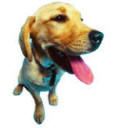
Pet Professional Tip
Offer clients a grooming "start-up" package that
includes the first few visits at a reduced rate
to introduce the dog to the facility and groomer
and to socialize the dog to the bathing area
with treats.
For older dogs, offer
sedation, if needed, to prevent physical or
psychological pain.
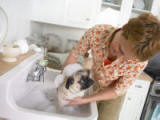
|
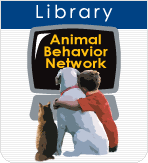 |
|
Help is at your
fingertips by library, email and
phone. |
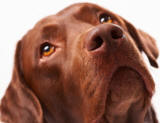
Click on
Library Icon
to learn more
|
Introduction
Every
creature on earth requires
some method or grooming to
maintain optimal physical and mental health. Puppies and dogs are no
exception. In addition to making pets more huggable, grooming can be
quality time together and reinforces
the human leadership role.
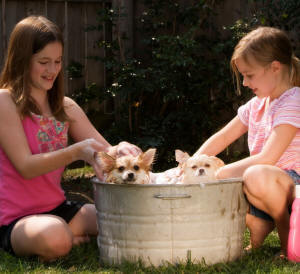
Ideally, bathing is introduced
in a positive way during the first few months of life when the puppy
is most impressionable.
The goal is to help the dog perceive
the bathtub
or sink a positive place. You
can do this in many creative
ways. One way is to feed the dog in
a dry tub for at least three to four days in a row before turning
the water on and off to get your dog use to that.
Ease your dog into the bathing
experience by working up to a wet
surface, then add an inch of water.
Use treats and praise to help the dog see being in the tub as one
way to earn your attention and treats.
Get the dog use to getting into a tub that has a little water in it.
A good time to do this is when your dog is very hungry so that you
can lure your dog in and reward your dog for staying in the tub with
treats. Once the dog is comfortable with
the water, go gently and slowly
being very careful not to get
water or soap into the dog's
eyes or ears. Provide quality
attention, praise, and food
treats while the dog is in the
bathtub.
Make sure the temperature of the water is luke
warm. Use a washcloth to massage the water into your dog's coat and
to apply the shampoo.
|
The goal in using sedation
is to give the dog the same
compassion as you want when
you go to the dentist,
"Please numb me first!" |
Begin slowly and
carefully
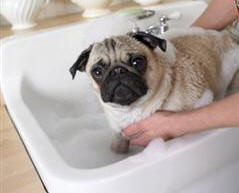 If
you want to use a professional groomer, let the groomer know that
your goal is for your dog to perceive professional grooming as a day at the Doggie Spa
- a positive experience. Offer to bring your dog in hungry and leave
a ziplock of your dogs favorite treats. If
you want to use a professional groomer, let the groomer know that
your goal is for your dog to perceive professional grooming as a day at the Doggie Spa
- a positive experience. Offer to bring your dog in hungry and leave
a ziplock of your dogs favorite treats.
A
good place to get "high-end" shampoos is from your
veterinarian. Use shampoos designed for dogs (not
people) since the pH of the human scalp is different
and the formulations of the shampoos are
significantly different. The highest quality (and
usually most expensive) shampoo is usually most gentle on the dog's skin.
Be careful not to get water into
the dog's eyes or ears. Use a wash cloth in these
areas. Trim fur inside ears that block
air getting into the ears especially if your dog is
prone to ear infections as a warm, moist environment
created by too much fur in the ears blocking air
flow invites bacterial infections.
Ask your
veterinarian to show you the proper way to clip a
dog's nails. You will want to start with one nail
tip each day coupled with
treats, praise and, if possible, followed by a walk. If
you cut of too much nail, the pain of the nail trim will cause your
dog to fight or try to avoid the process next time. If the dog objects, go more slowly. Older dogs may
need their toe nails trimmed by the veterinary staff
while under mild sedation to avoid pain and a
struggle.
Sadly, dogs that have been hurt or scared by
restraint during nail trims may become phobic. One goal is sedation to give the dog the same compassion as you want when
you go to the dentist, "Please numb me first!"
After the shampoo and the rinse, towel dry the dog
with lots of attention, praise, and happiness. You
can use a hair dryer if your dog tolerates it. But If he
or she does not, then gradually introduce the hair
dryer very slowly, coupled with treats and happy
talk.
A word of caution
Hair dryers can blow very hot air, making the
experience uncomfortable and sometimes even damaging
to the dog. Keep the
hair dryer constantly moving at a safe distance from
the dog. In addition, place one hand on the dog in
the area where the hair dryer is being applied and
use the other hand to hold the dryer. These
precautions will help prevent an adverse response to
the hair dryer, as well as injuries.
It may be kinder
to dogs with
several mats to be clipped short by a
professional groomer. If a
professional groomer is
required, find one willing to
proceed slowly, with food treats
to reward the dog for
appropriate behavior, or find a
veterinary practice that offers
sedation with grooming to spare
your dog physical and
psychological pain.
|